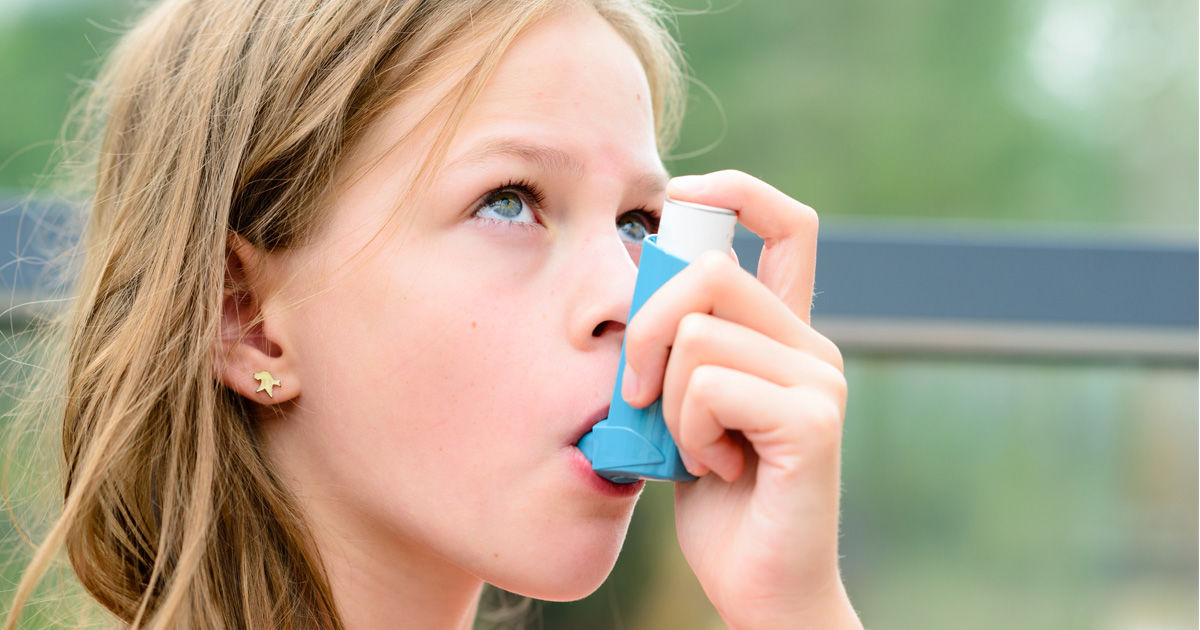F&V consumption on asthma, wheezing and immune responses
Asthma is a chronic lung inflammation, combined with a respiratory tract reduction, bronchial hyperresponsiveness and symptoms such as coughing, wheezing, dyspnoea and chest tightness. It is dependent on genetic and environmental factors. In some cases, e.g. exacerbation by viruses, treatments such as glucocorticoids can be ineffective and their prolonged use exposes patients to side effects such as pulmonary superinfection, cataracts and osteoporosis1. Nonpharmacological measures are therefore necessary to reduce the severity of asthma in adults and children. A better understanding of the role of food in the occurrence of this condition can help manage this chronic inflammatory disease.
A low F&V consumption can play a key role in the development of asthma and allergies
Numerous studies suggest that under-consumption of F&V can play a pivotal role in the development of asthma and allergies. This recent literature review by an Australian team assesses the link between the consumption of F&V and the risk of asthma, wheezing and immune responses. The studies published until June 2016 were collected from international databases.
58 studies were ultimately listed: 30 cross-sectional studies, 13 cohort studies, 8 case-control studies and 7 intervention studies. Most of them (n=30) found beneficial links between a high intake of F&V and the risk of asthma and/or respiratory function, while 8 found no significant connection. Twenty studies report mixed results, showing a negative link between the consumption of fruit or vegetables alone and asthma.
In addition, meta-analyses in adults and children showed inverse associations between fruit consumption and the risk of wheezing prevalence and asthma severity2,3. Similarly, the consumption of vegetables was negatively associated with the risk of developing asthma. Seven studies examined immune responses in relation to the consumption of F&V in asthma: 6 showed a protective effect against systemic or respiratory inflammation.
Beneficial effects of F&V in asthma
A cohort study carried out in Greece4 monitored children from birth to the age of 18. It showed that the daily intake of F&V over the previous 12 months was inversely associated with asthma at the age of 18.
Knekt et al.5 found a lower incidence of asthma in nearly 400 adults aged 30 to 69 associated with an increased intake of flavonoid-containing food (provided in particular by oranges, apples, grapefruit, onions, cabbage, berries and juices). The strongest associations were observed for apple and orange intakes.
A vast study (nearly 70,000 women)6 showed inverse associations between asthma and a high intake of tomatoes, carrots and leafy vegetables.
Nagel’s international ISAAC study7, which includes 50,000 children aged 8 to 12 in 20 countries, showed that the consumption of green vegetables was associated with a reduction in the number of children suffering from wheezing in poor countries only, while fruit consumption was associated with a low wheezing prevalence in rich as well as poor countries.
Furthermore, a one-year prospective study of more than 4,000 children aged 6 to 7 showed that a high intake of tomatoes, fruit and citrus fruits was associated with reduced shortness of breath8.
Consumption of F&V during pregnancy and risk of asthma in children
Inverse associations between the incidence of medically diagnosed asthma in children and a higher intake of F&V by the mother during pregnancy were reported by Fitzsimon et al.9.
According to Willers, the consumption of apples in 1,212 pregnant women reduced wheezing and asthma in children, as confirmed by a physician. No association however was demonstrated with the mother’s consumption of vegetables10.
Yet, another study showed that the consumption of vegetables more than 8 times a week was inversely correlated with persistent wheezing, without finding any association with fruit consumption11.
Protective effects of F&V on asthma: role of antioxidants
The protective effects of F&V on asthma and pulmonary function are explained by various mechanisms. More specifically, fresh F&V are rich in a combination of various antioxidants such as vitamins C and E (found in particular in corn, tomatoes, spinach, broccoli, kiwis, mangoes) and carotenoids (including lycopene, a powerful antioxidant, especially concentrated in tomatoes, red fruits, watermelon, apricots and pink grapefruit). Flavonoids (F&V polyphenols with powerful antioxidant and anti-inflammatory properties), isoflavonoids and phenolic compounds are also involved12.
Asthmatics suffer from high oxidative stress which increases during acute exacerbations. This is why a high intake of antioxidants may be beneficial13.
Additional studies are required to improve the identification of the biological mechanisms responsible for the effects of the consumption of F&V on asthma.
Based on: Hosseini B, Berthon BS, Wark P, Wood L. Effects of Fruit and Vegetable Consumption on Risk of Asthma, Wheezing and Immune Responses: A
Systematic Review and Meta-Analysis. Nutrients 2017. 9, 341.
References
- Andreeva-Gateva PA, et al. Postgrad. Med.2016, 128, 474–484.
- Mendes, A.P., et al. J. Asthma 2011, 48, 235–240.
- Barros, R., et al. Allergy 2008, 63, 917–923.
- Bacopoulou F, et al. J. Asthma 2009, 46, 171–174.
- Knekt P, et al. Am. J. Clin. Nutr.2002, 76, 560–568.
- Romieu I, et al. Thorax 2006, 61, 209–215.
- Nagel G, et al. Thorax 2010, 65, 516-522.
- Farchi S, et al. Eur. Respir. J.2003, 22, 772–780.
- Fitzsimon N, et al. Ir. Med. J.2007, 100, 27–32.
- Willers SM, et al. Thorax 2007, 62, 773–779.
- Chatzi L, et al. Thorax 2008, 63, 507–513.
- Okoko BJ, et al. Eur. Respir. J.2007, 29, 1161–1168.
13. Leonardi S, et al. Allergy Asthma Proc.2014, 35, 51–56.

